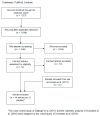Dose-Response Relationship between Physical Workload and Specific Shoulder Diseases-A Systematic Review with Meta-Analysis
- PMID: 32075183
- PMCID: PMC7068556
- DOI: 10.3390/ijerph17041243
Dose-Response Relationship between Physical Workload and Specific Shoulder Diseases-A Systematic Review with Meta-Analysis
Abstract
Several epidemiological studies have found an association between shoulder-loaded work activities and specific shoulder diseases. No study has derived the dose-response relationship and resulting doubling dose, important for the recognition of occupational diseases. This systematic review is an update of the van der Molen et al. (2017) review. Based on its methodologies, we identified new studies published up to November 2018. The dose-response relationship between physical occupational demands (hands at/above shoulder level, repetitive movements, forceful work, hand-arm vibrations) and specific shoulder diseases (defined as ICD-10 M 75.1-5: rotator cuff syndrome, bicipital tendinitis, calcific tendinitis, impingement, and bursitis) was derived. No evidence for sex-specific differences in the dose-response relationship was found. If there were at least two studies with comparable exposures, a meta-analysis was carried out. The pooled analysis resulted in a 21% risk increase (95% CI 4-41%) per 1000 h of work with hands above shoulder level. A meta-analysis was not possible for other occupational burdens due to the low number of studies and differing exposure measurements; an estimate of the doubling dose was made based on the cohort study of Dalbøge et al. (2014). To conclude, the present systematic review with meta-analysis contributes to knowledge of the level of exposure at which specific shoulder diseases-particularly rotator cuff lesions-should be recognized as an occupational disease.
Keywords: dose-response relationship; doubling dose; musculoskeletal diseases of the shoulder; occupational disease; physical workload; rotator cuff lesions.
Conflict of interest statement
The authors declare no conflict of interest.
Figures
Similar articles
-
Shoulder Tendinopathies and Occupational Biomechanical Overload: A Critical Appraisal of Available Evidence.Med Lav. 2023 Aug 2;114(4):e2023033. doi: 10.23749/mdl.v114i4.14537. Med Lav. 2023. PMID: 37534424 Free PMC article.
-
Risk factors for rotator cuff tendinopathy: A systematic review and meta-analysis.J Rehabil Med. 2019 Oct 4;51(9):627-637. doi: 10.2340/16501977-2598. J Rehabil Med. 2019. PMID: 31489438
-
Occupational Stress as a Possible Risk Factor for Rotator Cuff Damage - Systematic Review and Meta-analysis.Z Orthop Unfall. 2024 Jun;162(3):289-295. doi: 10.1055/a-1957-6140. Epub 2022 Dec 6. Z Orthop Unfall. 2024. PMID: 36473486 English, German.
-
Shoulder tendinitis and its relation to heavy manual work and exposure to vibration.Scand J Work Environ Health. 1993 Feb;19(1):43-9. doi: 10.5271/sjweh.1505. Scand J Work Environ Health. 1993. PMID: 8465171
-
Natural course of nontraumatic rotator cuff tendinitis and shoulder symptoms in a working population.Scand J Work Environ Health. 2006 Apr;32(2):99-108. doi: 10.5271/sjweh.985. Scand J Work Environ Health. 2006. PMID: 16680380
Cited by
-
Shoulder Tendinopathies and Occupational Biomechanical Overload: A Critical Appraisal of Available Evidence.Med Lav. 2023 Aug 2;114(4):e2023033. doi: 10.23749/mdl.v114i4.14537. Med Lav. 2023. PMID: 37534424 Free PMC article.
-
Physical Work Demands of Maintenance Workers on Onshore Petroleum Facilities in Norway: An Observational Study Utilizing Wearable Sensor Technology.Ann Work Expo Health. 2023 Jul 6;67(6):706-719. doi: 10.1093/annweh/wxad022. Ann Work Expo Health. 2023. PMID: 37171985 Free PMC article.
-
Occupational tasks associated with shoulder pain and upper extremity disability: a cross-sectional study in the Johnston County Osteoarthritis Project.BMC Musculoskelet Disord. 2024 May 11;25(1):374. doi: 10.1186/s12891-024-07487-x. BMC Musculoskelet Disord. 2024. PMID: 38730454 Free PMC article.
-
The OCCHLTH Mnemonic-Construction and Content of a Tool for Increasing Awareness of Occupational Illness and Injury.J Occup Environ Med. 2024 May 1;66(5):403-420. doi: 10.1097/JOM.0000000000003075. Epub 2024 Feb 20. J Occup Environ Med. 2024. PMID: 38709181 Free PMC article. Review.
-
Occupational demands associated with rotator cuff disease surgery in the UK Biobank.Scand J Work Environ Health. 2023 Jan 1;49(1):53-63. doi: 10.5271/sjweh.4062. Epub 2022 Oct 13. Scand J Work Environ Health. 2023. PMID: 36228192 Free PMC article.
References
-
- Svendsen S.W., Dalbøge A., Andersen J.H., Thomsen J.F., Frost P. Risk of surgery for subacromial impingement syndrome in relation to neck-shoulder complaints and occupational biomechanical exposures: A longitudinal study. Scand. J. Work Environ. Health. 2013;39:568–577. doi: 10.5271/sjweh.3374. - DOI - PubMed
Publication types
MeSH terms
LinkOut - more resources
Full Text Sources
Medical



